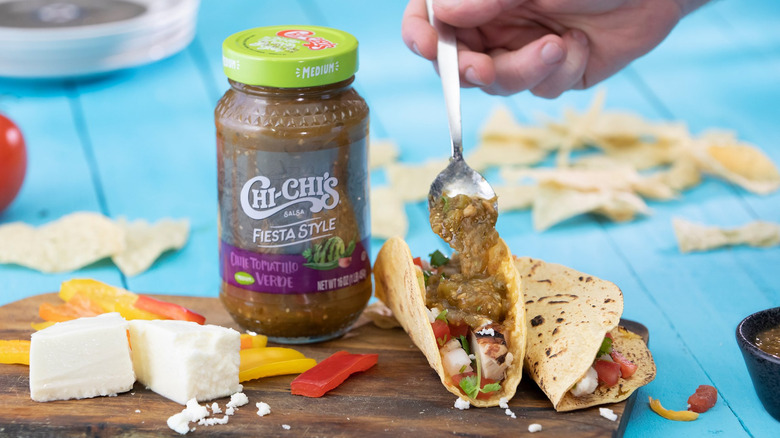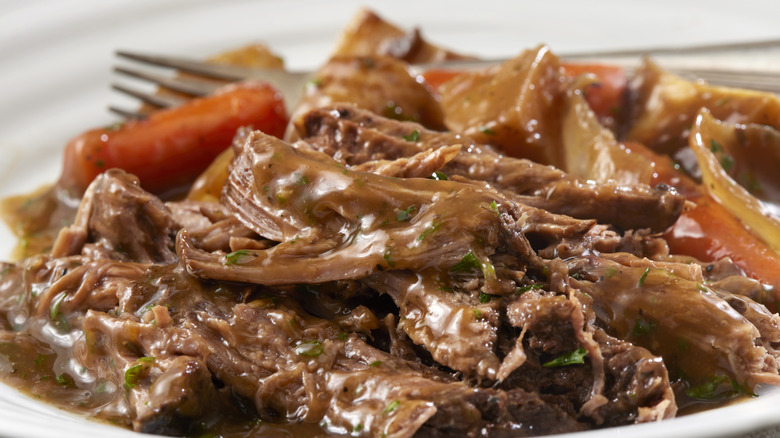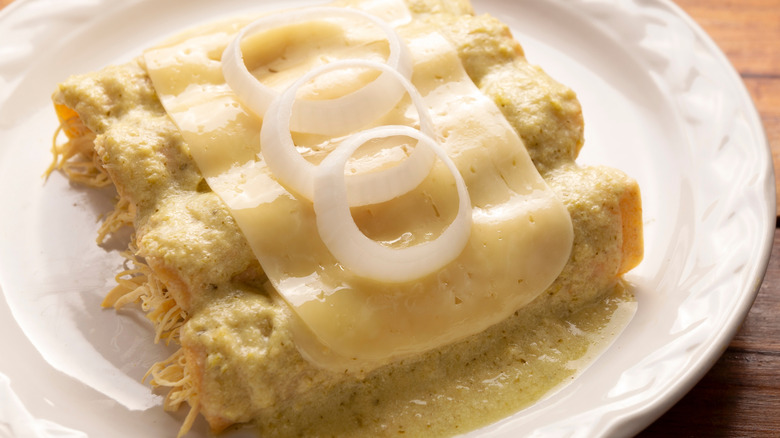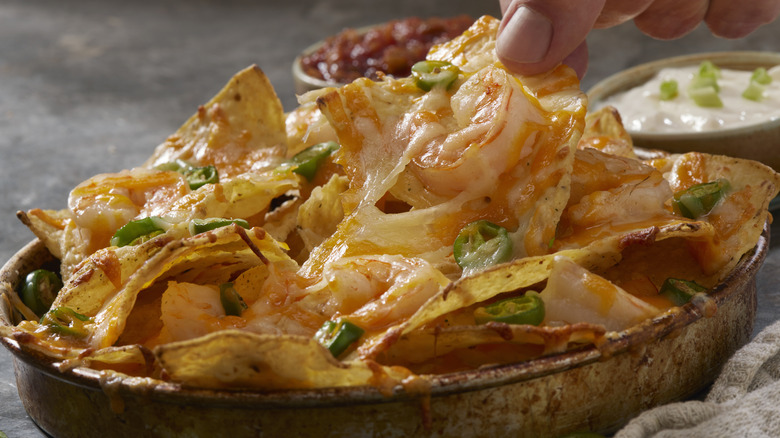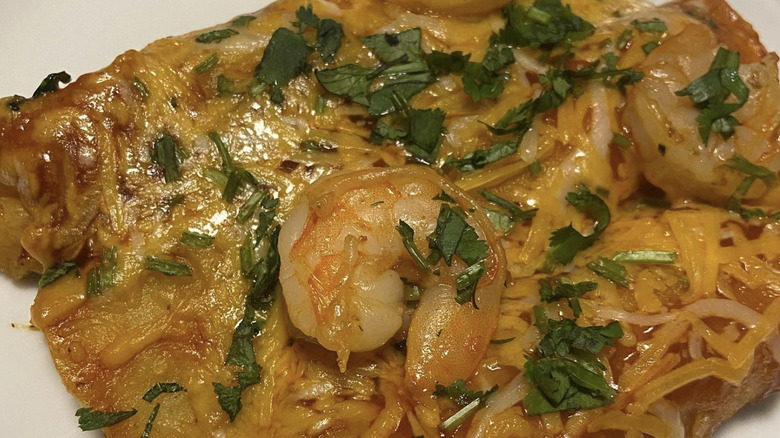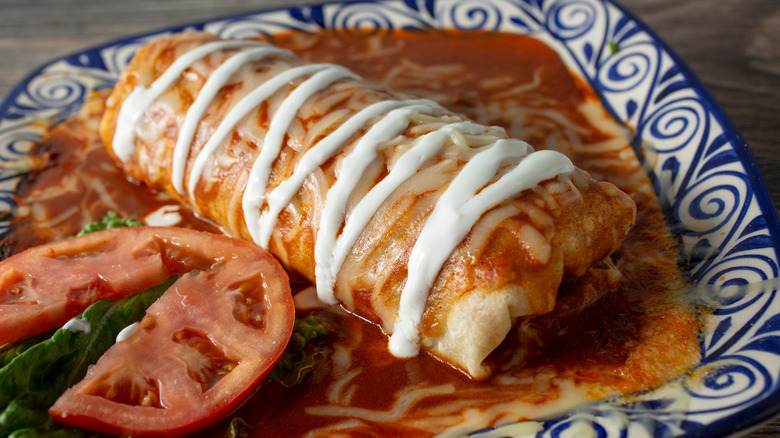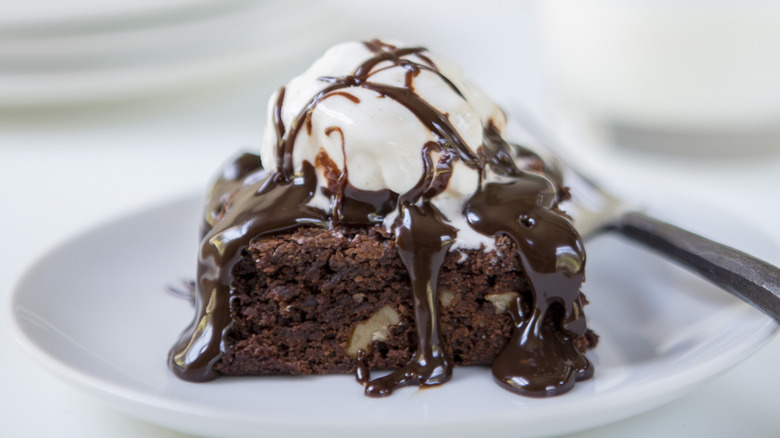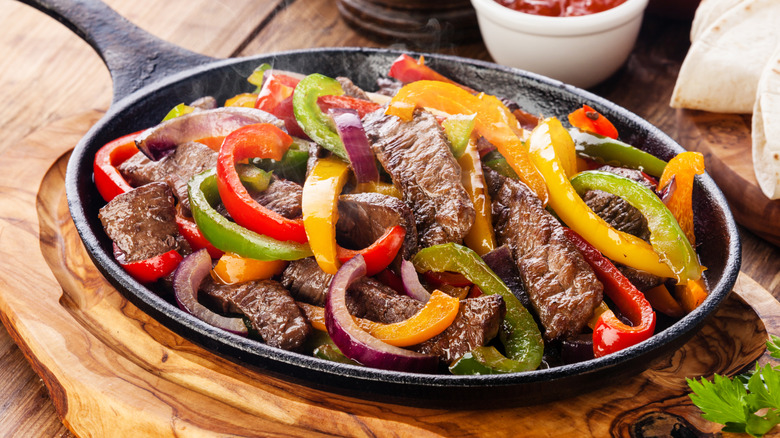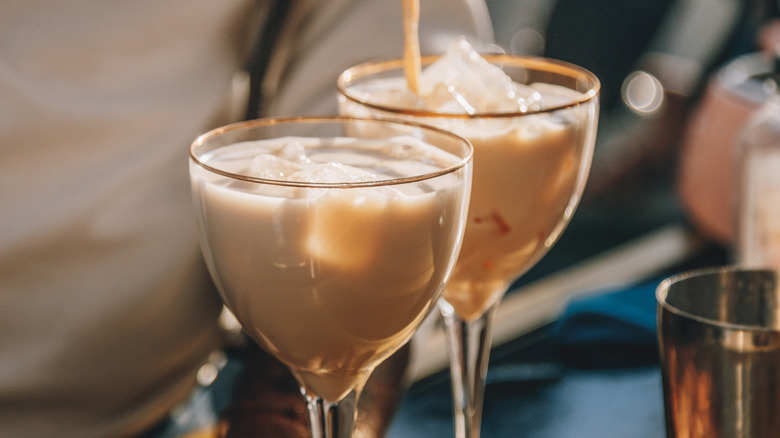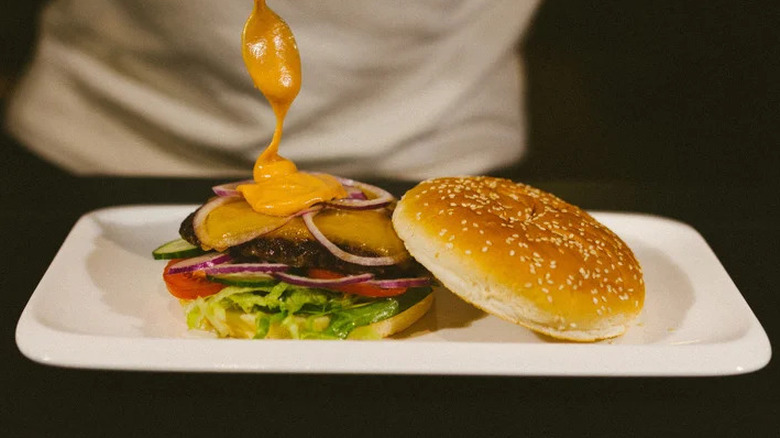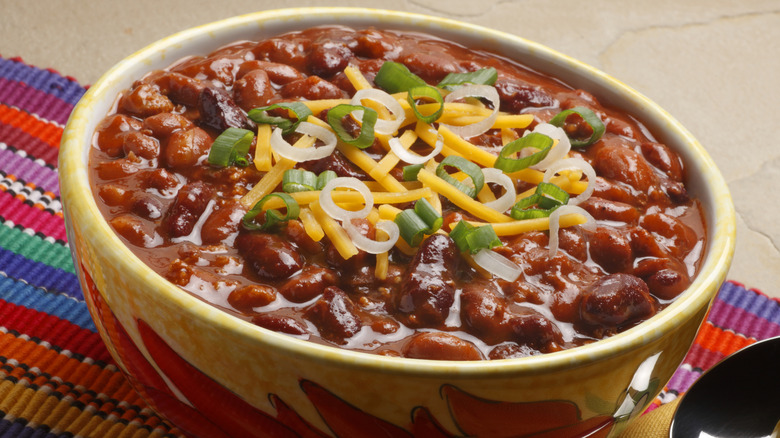Chi-Chi's Menu Items That Should Stay In The Past
What ever happened to Chi-Chi's restaurants? Once a major sit-down chain comprising more than 200 chains, it's a once-popular restaurant that filed for bankruptcy. Chi-Chi's helped to popularize Mexican-inspired and Tex-Mex cuisine across the United States. Positively huge in the 1970s and 1980s, it closed down in 2004 and exists now as a line of salsas, tortilla chips, and Mexican seasoning blends. Food conglomerate Hormel owns the Chi-Chi's trademark, and in 2024, it set in motion plans for a revival. Michael McDermott, son of Chi-Chi's co-founder Marno McDermott, is heading up the charge to bring back the once mighty chain.
If that comeback winds up happening, it's probably likely that the new Chi-Chi's will revive a lot of its classic menu items, mostly familiar and crowd-pleasing dishes like tacos, burritos, and enchiladas. But hopefully Chi-Chi's 2.0 will decide to leave off of the menu some of the other items it sold over the years, culinary abominations and curious concoctions that were a bit too ambitious or just downright gross. Here are the dishes that we hope a revived Chi-Chi's doesn't resurrect.
Yucatan Style Pot Roast
Chi-Chi's went out of business in the United States in 2004. It probably doesn't have anything to do with one of its most recent menu additions from the time, but it certainly didn't help that the chain was trying to hold on by introducing strange, visually and flavorfully unappetizing fusion dishes like the Yucatan Style Pot Roast.
An attempt to meld Mexican-style flavors with down-home Euro-American comfort food, the Yucatan Style Pot Roast is full of inconsistencies and inaccuracies. Firstly, the regional cuisine of the Yucatan is much more based around poultry and pork dishes rather than beef. This Chi-Chi's dish was made with barbacoa, a preparation of slow-roasted beef that began in the Caribbean, not Mexico. And as this dish is made with the Chi-Chi's barbacoa found in many other dishes, it's not really even a pot roast. The Yucatan Style Pot Roast was completed with the addition of a random melange of mixed vegetables like zucchini and tomatoes, sautéed in a pan until soggy, as well as mashed potatoes laced with cheddar cheese and Mexican spices. "It's warm, heart, and delicious," the menu copy promises, more than a little defensively. Chi-Chi's also suggests a premium tequila-based margarita to wash the thing down, which is probably more necessary than complementary.
Lobster Enchiladas
Whether in a restaurant or home kitchen, cheese and seafood is a tough combination to make work. Many cheeses can turn gelatinous, greasy, and gloopy when melted, such as when they're used in Mexican-style foods, and their strong flavors can overpower the more delicate and subtle taste of fish, which if it's not fresh, may add some unpleasant foulness to any dish. This made Chi-Chi's lobster enchiladas a questionable and unappealing choice for the menu, back when the restaurant was still bringing in customers, and now, as it looks toward a revival.
As described on a circa early 2000s Chi-Chi's menu, the lobster enchiladas came two to an order and were flanked with rice, beans, and a sweetened corn cake. Into a couple of unassuming tortillas, kitchen staff stuffed a small to moderate bit of lobster (so as to keep the $9.99 price point profitable) along with cheddar cheese and jack cheese. Then it all got topped with a spicy cream-based sauce.
Seafood Nachos
While one could easily forget the beef and give loaded nachos a seafood twist, it takes some more alterations to the classic Mexican dish of chips, cheese, and various additions to make it work. As late as the 2000s, right before the entire chain closed up shop, Chi-Chi's sold a nachos platter from the appetizer section of its menu. The item came standard with tortilla chips loaded up with cheese as well as hefty portions of sour cream, pico de gallo, and jalapeño slices. For an additional charge, customers could request a protein option: beef and bean, chicken, seafood, or a sampler of all three styles.
When made with seafood (it's curiously and alarmingly not specified on the menu what kind Chi-Chi's planned to use), the only thing the restaurant changed about the usual nacho presentation is that it gets rid of the jalapeños. Otherwise, the dish was a fatty, overwhelming mismatch of mainstream Tex-Mex flavors with the dissonant flavors and textures of fish.
Bayou Shrimp Enchiladas
Fusion, the food concept of combining two different culinary traditions to create one new and inventive assortment of dishes, is a wonderful thing — in theory. Sometimes it works quite well, as seemingly disparate cultures may have many ingredients in common, or the flavors happen to mesh together nicely. But sometimes fusion fails, because no matter how hard a corporate chef may try, they just can't get two unlikely sets to merge. Such was the case in the 1990s, when Chi-Chi's, built on a menu that already combined Texas food with Mexican food, attempted to put its spin on Louisiana-based Cajun-Creole cuisine.
The menu offering was called Bayou Shrimp Enchiladas, and it utilized both the Tex-Mex profile and the uniquely bold, sweet, spicy, unique, and powerful flavors of the Cajun and Creole style. That's a lot of strong flavor competing for dominance, rather than blending. The tossing of a couple of shrimp atop the enchiladas didn't do much to build a bridge, either.
Outrageous Burrito
American chain restaurants occasionally earn criticism for normalizing gigantic portion sizes, which could lead to an ongoing obesity epidemic. Chi-Chi's arguably helped contribute to this trend back in the 1980s with its massive plates of affordably priced, Mexican-style food. One of the most imposing, mountainous, and calorically impactful items that the chain ever sold, and should probably think twice about selling again in its upcoming new iteration, is the Outrageous Burrito.
The number one item on the "Chi-Chi's Originals" mid-2000s menu section of recommended specialties, the aptly named Outrageous Burrito was a gigantic beast marketed as a meal for one. Restaurants just don't want customers splitting plates, even on this item that could have fed multiple adults. Inside of an extra-large tortilla came slices of both chicken and grilled steak as well as beans, rice, pico de gallo, and queso sauce. As if that wasn't enough, this stomachache waiting to happen was slathered in two more condiments: suprema sauce and enchilada sauce.
Chocolate Bandido
While it would be best if some Chi-Chi's menu items from long ago didn't make a return appearance over various cultural or culinary snafus, the Chocolate Bandido shouldn't reappear at the new Chi-Chi's because it could be classified as a threat to public health. Certainly one of the most calorically voluminous chain restaurant desserts in history, as well as among the most unabashedly full of carbohydrates and sugar, the Chocolate Bandido is big enough to feed multiple restaurant patrons. In its description of the item on a 1991 menu, Chi-Chi's notes now it arrives at diners' table with two spoons — as if to suggest that it's dangerous for just one person to tackle the thing.
The Chocolate Bandido was basically a brownie sundae — but it's actually four brownie sundaes. The dessert was made with four chocolate walnut brownies, which were then topped with scoops of French vanilla ice cream, and then all of that was slathered in hot fudge sauce. "Bandido" is Spanish for "bandit," and the Chocolate Bandido robbed Chi-Chi's diners of solid blood sugar control.
Chajitas
There wasn't anything particularly egregious about the fajitas available at Chi-Chi's throughout its reign as one of the U.S.'s top Tex-Mex chains. Presented in a hot skillet alongside peppers and onions, and served with rice, beans, and condiments, Chi-Chi's fajitas could be ordered with chicken, skirt steak, shrimp, or mixed vegetables.
By the 2000s, Chi-Chi's had renamed the line Flaming Grilled Fajitas, after years of calling the Mexican restaurant stalwart dish "Chajitas." Taking ownership of a dish it by no means invented was a bit tacky, especially when the chain made a portmanteau out of its own name and fajitas and then registered it as a trademarked phrase. Let's hope that when Chi-Chi's comes back in 2025 and beyond, it just calls its fajitas by the name which most everybody knows. "Chajitas" should stay in the past, as should the cringe-inducing pronunciation guide ("cha-HEE-tas") under the word in Chi-Chi's 1990s menus.
Chi-Chi's Delight
Like any middle-of-the-road, crowd-pleasing chain restaurant, at nearly any point in the last half century, Chi-Chi's sold a wide array of alcoholic beverages. Subject to a significant markup and helping its bottom line, Chi-Chi's "Cantina" menu section in the 1980s included common Mexican restaurant beverage choices, like imported bottled Mexican beer, wine, sangria, daiquiris, and margaritas. It also sold two after-dinner cocktails. Along with the Ke-o-Ke Koffee, a mixture of Kahlua, brandy, and coffee, Chi-Chi's served a drink that sounds like a bad and gross combination, and certainly not something most people would want to eat after eating a towering platter of nachos or a huge burrito.
The drink that should remain only on a 1980s-era Chi-Chi's menu is the Chi-Chi's Delight. It's a boozy coffee, laced with the sensibly coffee-flavored liqueur Kahlua as well as a hit of powerful, caustic tequila. Then these incongruous ingredients are blended together along with whipped topping — which is either Cool Whip (and Chi-Chi's wasn't allowed to name-check it on the menu) or an off-brand imitation of Cool Whip.
Tex-Mex sandwiches
By the early 1990s, Mexican-inspired cuisine was well entrenched across the United States. Taco Bell rivaled McDonald's in customers and revenue and salsa was the country's best-selling condiment but Chi-Chi's still, and vaguely condescendingly, treated Americanized Mexican food as exotic cuisine. Still not quite sure if its customers would be able to handle or understand things like burritos, enchiladas, and fajitas, the Chi-Chi's menu as late as 1991 included fully American fare like burgers and chicken sandwiches, but given an unnecessary Mexican-ish flourish.
Any present-day re-creation of Chi-Chi's wouldn't need to hedge its bets. People go to Mexican restaurants for Mexican food, and they likely won't need to go searching for the sandwiches that have been topped with gateway ingredients. The Chi-Chi's hamburger, served Tex-Mex style, meant that the ⅓-pound patty had been marinated with Tex-Mex barbecue sauce (which likely couldn't cut it in The Takeout's barbecue sauce smackdown) and then given a slice of pepper jack cheese. The Tex-Mex Chicken Sandwich consisted of a boneless chicken breast given the same treatment of Tex-Mex barbecue sauce and slightly spicy cheese.
San Antonio Chili
Authenticity is important to contemporary restaurants. A chain would likely be savaged on social media and by food critics if they were to proudly and boldly put an item on its menu that didn't adhere to the traditional or historical style of preparation to which generations of fans had become steadfastly devoted. It would be an awkward act bordering on cultural appropriation then for the new Chi-Chi's, which could open a couple of outlets in Minnesota in 2025, to bring back its predecessor's 1980s-era San Antonio Chili.
While a 1990s version of the Chi-Chi's menu claimed that the restaurant had won awards for its chili (without sourcing that information), this item was made with ground beef, pork, and pinto beans. That doesn't much resemble real San Antonio chili.The one unbreakable rule of Texas chili: Don't use beans. San Antonio chili historically adheres to that, nor is it made with ground meat of any kind — the standard recipes call for a spicy stew made with big, whole hunks of beef and pork.
